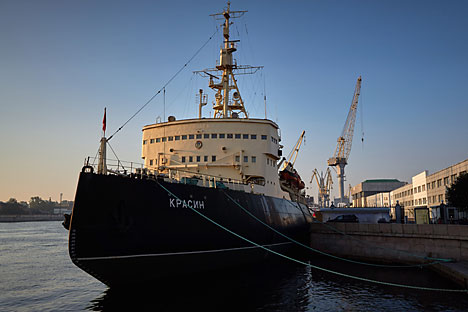Russian military building own icebreaker fleet

In Russia, there is a tradition of naming icebreakers after their predecessors. Source: Alexei Danichev / RIA Novosti
Nature itself assists the Russian military in preventing the deployment of the US Navy in the northern seas. Numerous islands are located there, on which former Soviet military bases are being revived. The seas are covered with ice, which hinders the arrival of large marine forces of any opponent in these latitudes. Their maneuverability is reduced, and safe cover from aerospace reconnaissance is provided for Russian submarines.
Arctic hero
However, these advantages create inconveniences also for the Russian Navy. First of all, it becomes difficult to replenish supplies to troops, and move equipment and cargo, most of which has to be delivered by sea.
Today Russia has the largest ice fleet, with 6 atomic-powered and 20 diesel electric icebreakers, and about 40 ice-class vessels.
To resolve this problem, the Russian Navy has sought the development of a new type of diesel-electric icebreaker. The keel of the first ship in this series was laid this week, and was named after a Russian folk hero, Ilya Muromets, who protects ordinary people from invaders and robbers.
In Russia, there is a tradition of naming icebreakers after their predecessors. In this case, the “godfather” of the new ship was a project 97K icebreaker, also built in the Admiralty Shipyards back in 1965, which served in the Pacific Fleet until 1993.
This ship inherited its name from a predecessor, which was built in England in 1916 for the needs of the Russian Navy. The fate of that Ilya Muromets, however, was not very illustrious.
After the outbreak of civil war in Russia, Entente troops intervened in northern Russia and stole this ship, which then completed its service life in the French Navy, used as a minelayer, called Pollux.
The current ship is being built for the exact purpose of preventing any invasion from hostile states through the territorial waters of Russia. It will become the first ship of this class built for the Russian Navy in the past 40 years. Its builders have tried to include all available technological innovations into this vessel.
“When the ship was being designed, they gave it capabilities not of today’s icebreakers, but those of tomorrow. These include seaworthiness, maneuverability, versatility and a completely new electric principle of movement,” said Admiral Viktor Chirkov, during the keel-laying ceremony for this ship.
The new vessel will be 85 meters in length, almost 20 meters wide and have a displacement of 6,000 tons, with cruising endurance of 60 days. A total of four ships of this kind will be built.
An important feature of the Ilya Muromets is the Azipod-type steerable propellers. These are secured to the hull by a hinge mechanism and can rotate 360 degrees about a vertical axis, which allows the ship to freely move forward, backward, and sideways. These capabilities are especially useful when operating the vessel as an ice tugboat.
In Focus – Northern Sea Route
In 2017, they will hoist the St. Andrew’s flag on the new icebreaker, and it will immediately begin escorting supply ships. Its hull can break through ice that is up to one meter thick, thus allowing it to operate along the entire length of the Northern Sea Route (NSR), and ensuring that ships can travel from Murmansk to Petropavlovsk-Kamchatsky. The new ship has the capacity to easily cover this distance.
The NSR will allow cargo to travel from the North of European Russia to the Far East between seven and 22 days faster than through the Suez Canal. Additionally, Russia will be shipping cargo through its own territorial waters, allowing it to proceed without worrying about the decisions of other states and, in the event of war, the logistics will be considerably safer.
Beginning in 2011, merchant shipping along the NSR has been steadily increasing. By the years 2019-2020, cargo shipments via this route will grow to 5 million tons per year. This requires that Russia be able to ensure the security of this shipping corridor in the interests of its own vessels and those of its closest partners, for example, China.
All rights reserved by Rossiyskaya Gazeta.
Subscribe
to our newsletter!
Get the week's best stories straight to your inbox
